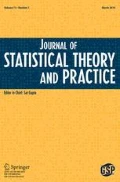Abstract
There are mainly two approaches to compare effects of two treatments: following the intersection–union principle (IU) or following the union–intersection principle (UI). The two approaches substantially differ by the role stated from the null and alternative hypotheses, which are mirror inverted. In particular, the IU principle considers as alternative hypothesis that the effect of a new treatment lies within a given interval around that of the comparative treatment, whereas the UI principle considers as alternative hypothesis that this effect lies outside that interval. Pesarin et al. recently discussed these two solutions and proposed a permutation approach based on the union-intersection framework.
Often in pharmaceutical experiments it happens that more than one variable have to be simultaneously considered, in order to assess dissimilarity of two treatments. Generally this kind of problem is difficult to face outside the nonparametric framework, particularly due to the complex dependency structure among several variables and consequent related partial tests. Thus, the purpose of this article is to extend the existing UI-permutation solution toward a general multidimensional setting. In order to explain the performance and the applicability of the proposed method, a simulation study and application example are also shown.
Similar content being viewed by others
References
Arboretti Giancristofaro, R., S. Bonnini, L. Corain, and L. Salmaso. 2016. Dependency and truncated forms of combinations in multivariate combination-based permutation tests and ordered categorical variables. Journal of Statistical Computation and Simulation 86 (18):3608–19.
Arboretti Giancristofaro, R., S. Bonnini, L. Corain, and L. Salmaso. 2014. A permutation approach for ranking of multivariate populations. Journal of Multivariate Analysis 132:39–57.
Basso, D., F. Pesarin, L. Salmaso, and A. Solari. 2009. Permutation tests. In Permutation tests for stochastic ordering and ANOVA, 1–35. New York, NY: Springer.
Bertoluzzo, F., F. Pesarin, and L. Salmaso. 2013. On multi-sided permutation tests. Communications in Statistics — Simulation and Computation 42 (6):1380–90.
Corain, L., R. Arboretti, and S. Bonnini. 2016. Ranking of multivariate populations - a permutation approach with applications. Boca Raton, FL: Chapman & Hall/CRC.
Corain, L., and L. Salmaso. 2013. Nonparametric permutation and combination-based multivariate control charts with applications in microelectronics. Applied Stochastic Models in Business and Industry 29 (4):334–49.
Corain, L., and L. Salmaso. 2007. A nonparametric method for defining a global performance ranking of industrial products. Journal of Applied Statistics 34 (2):203–16.
Cox, D. R., and D. V. Hinkley. 1974. Theoretical statistics. London, UK: Chapman and Hall.
Hoffelder, T., R. Gössl, and S. Wellek. 2015. Multivariate equivalence tests for use in pharmaceutical development. Journal of Biopharmaceutical Statistics 25:417–37. DOI: 10.1080/10543406.2014.920344.
Lehmann, E. L. 1986. Testing statistical hypotheses, 2nd ed. New York, NY: Wiley.
Pesarin, F. 1990. On a nonparametric combination method for dependent permutation tests with applications. Psyclotherapy and Psyclosomatics 54 (2–3):172–79.
Pesarin, F., L. Salmaso, E. Carrozzo, and R. Arboretti. 2014. Testing for equivalence and non-inferiority: IU and UI tests within a permutation approach. In JSM Proceedings — Nonparametric statistics section, 2573–2580. Alexandria, VA: American Statistical Association.
Pesarin, F., L. Salmaso, E. Carrozzo, and R. Arboretti. 2016. Union–intersection permutation solution for two-sample equivalence testing. Statistics and Computing 26:693–701.
Pesarin, F., and L. Salmaso. 2010. Permutation tests for complex data, theory, applications and software. Chichester, UK: Wiley.
Roy, S. N. 1953. On an heuristic method of test construction and its use in multivariate analysis. Annals of Mathematical Statistics 24 (2):220–38.
Saranadasa, H., and K. Krishnamoorthy. 2005. A multivariate test for similarity of two dissolution profiles. Journal of Biopharmaceutical Statistics 15:265–78.
Sen, P. K. 2007. Union–intersection principle and constrained statistical inference. Journal of Statistical Planning and Inference 137:3741–52.
Zaykin, D. V., L. A. Zhivotovsky, P. H. Westfall, and B. S. Weir. 2002. Truncated product method for combining p-values. Genetic Epidemiology 22:170–85.
Author information
Authors and Affiliations
Corresponding author
Rights and permissions
About this article
Cite this article
Arboretti, R., Carrozzo, E., Pesarin, F. et al. A multivariate extension of union—intersection permutation solution for two-sample testing. J Stat Theory Pract 11, 436–448 (2017). https://doi.org/10.1080/15598608.2017.1295891
Received:
Accepted:
Published:
Issue Date:
DOI: https://doi.org/10.1080/15598608.2017.1295891
Keywords
- Union–intersection principle
- nonparametric combination
- Multivariate hypothesis testing
- Permutation tests




